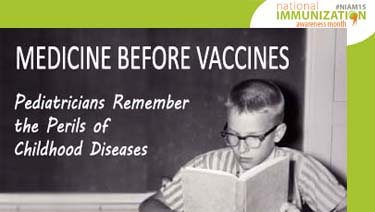Vaccines: Making strides in converting deniers
 |
Credit: American Academy of Pediatricians
|
August is National Immunization Month which seems as good a time as any to evaluate how we are doing at getting the science based message about vaccines out to the public. Numbers actually show we are doing a good job in converting anti-vaxxers. A poll conducted by the University of Michigan found that:
- 34 percent of parents think vaccines have more benefit than they did one year ago
- 25 percent of parents believe vaccines are safer than they were one year ago
- 35 percent of parents report more support for daycare and school vaccine requirements than one year ago
It’s therefore important to understand how these changes in the public perception of vaccines have occurred.
One recent study found that the best way to change opinions on vaccines is to focus on the risks of not vaccinating, instead of focusing on correcting directly the myths the anti-vax movement is infamous for spreading.
Researchers working at the University of Illinois polled subjects on their vaccine views and then separated them into three groups: one received literature challenging the anti-vax group, one received literature focused on the diseases vaccines protect against and one received literature on a non-vaccine topic. After after parents read their respective literature, they were re-polled and the researchers found that many in the second group changed their opinions on vaccinations.
Lead researcher Zachary Horne said of their results: “We found that directing people’s attention to the risks posed by not getting vaccinated, like getting measles, mumps and rubella and the complications associated with those diseases, changed people’s attitudes positively towards vaccination — and that was for even the most skeptical participants in the study. Actually, the largest effect sizes were for people who were the most skeptical.”
This idea is not new and is often put in a historical context. People stood in long lines in the mid 20th century to get themselves and their children vaccinated against the flu and polio, but this was a time when both of these diseases caused very visible epidemics. Yet the last case of polio in the United States was in 1979, almost 40 years ago, so it is understandably harder for people under the age of 40 to grasp the risks of acquiring one of these vaccine preventable diseases.
Think about the aforementioned Michigan study in light of last year’s Disneyland measles outbreak. Measles became a more public, tangible disease to many people, in particular young parents. This outbreak and the publicity it garnered may explain why the Michigan study found such a drastic movement away from anti-vax views among parents.
With this idea in mind and in the spirit of National Immunization Month, the American Academy of Pediatrics has started a month long campaign to remind people of the risks of not getting vaccinated. The campaign, entitled “Medicine Before Vaccines” features a collection of stories from physicians who remember what pediatric medicine was like before vaccines. It should serve as a lesson to many young parents that vaccine preventable diseases are something to be feared, as they have been for most of human history.
http://acsh.org/2015/08/making-strides-in-converting-the-unconvertable/



